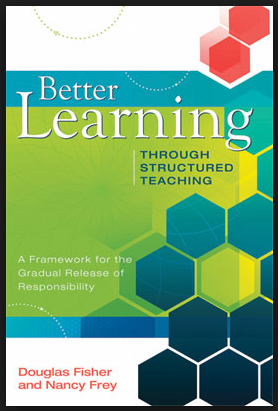I wish I could go back and improve my instructional support by including, as much as possible, modeling and think alouds.
What evidence do I have to back up my claim?
I'm going to pull all of my thinking from Douglas Fisher and Nancy Frey's book Better Learning Through Structured Teaching: A Framework for the Gradual Release of Responsibility (2008).
- "The gradual release of responsibility model of instruction suggests that the cognitive load should shift slowly and purposefully from teacher-as-model, to joint responsibility, to independent practice and application by the learning." (p. 2) When I think of this quote, I realize that modeling and think alouds are the best first step in shifting the cognitive load to students. Too often, we begin learning activities by simply assigning tasks. We use phrases such as 1) you're going to do this, or 2) remember to do this next, or 3) you need to make sure that... We want students to succeed, but we forget that a crucial scaffold for their success involves inviting students into our brains to see how we think. Consider how phrases within a think aloud or model differ from what I just mentioned. In modeling or a think aloud, we use phrases such as 1) I notice that, or 2) when I see this, it causes me to think about, or 3) as I think, I also ask this question. The shift in language is important because it shows students what is going on inside our heads when we use "I" versus assigning a task using "You are going to." The modeling and think aloud experiences are used intentionally to support students as we (teachers) shift the cognitive load to students.
- "In the gradual release of responsibility model, the focus lesson is the modeling phase. For a focus lesson to be effective, teachers must clearly establish a purpose and model their own thinking." (p. 4) The purpose for a lesson may involve a variety of goals, including skill goals, conceptual goals, language goals, and/or social goals. All students succeed better when they know what the thinking or work looks like. When we model or engage in a think aloud connected to the goals, we have set a clear purpose and provided the proper scaffolding for students. As we move through the classroom to formatively assess their ability to implement the stated goal(s), we can start to determine what students need more support in the application of a skill or the application of conceptual thinking. If we don't spend time at the beginning intentionally modeling or doing a think aloud, it's possible that we'll see far more students who need support with our intended goals. Thus, we might have a skewed vision of who needs support because we never took the time to model the thinking in the first place. Modeling and think alouds prepare students for their tasks and allow teachers to see, with greater accuracy, just who is having difficulty with the thinking that's needed in their work.
- "Focus lessons are not intended as a time to ask students questions. During the focus lesson, the teacher should model his or her thinking and not interrogate students about their thinking. As such, the teacher should use a number of 'I' statements, such as 'I think...' or 'I wonder...' or 'I predict...' ...Of course, the teacher asks students to talk with a partner to practice the skill or strategy of the focus lesson following the teacher modeling. The important thing to remember is that students need modeling - examples - that they can incorporate into their habits." (p. 18) We must stop assigning tasks and asking students to play the game of, "Guess how you're supposed to think." We want students to think, therefore we must constantly show them how we think. Consider this, would you ever put an 18-year old in a car and ask them to drive without modeling the proper skills and thought processes that are needed? NO, because that's insane. That is DANGEROUS! What if we thought of teaching that way? What if we don't show students the thought processes that are needed for the skill tasks and conceptual tasks we ask them to do? While it may not feel dangerous, it definitely doesn't prepare them appropriately.
Since I can't go back in time, I'm asking you to do it for me based on everything I now understand about teaching and learning. Change just one thing...be more effective and consistent in your use of modeling and think alouds.


No comments:
Post a Comment